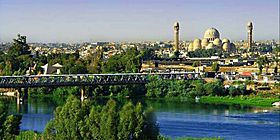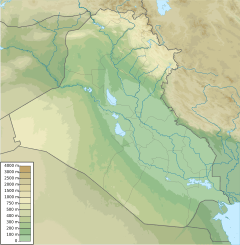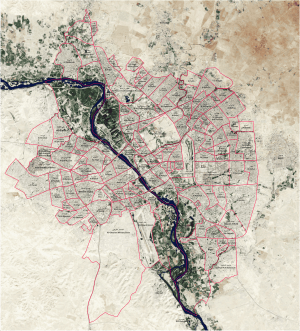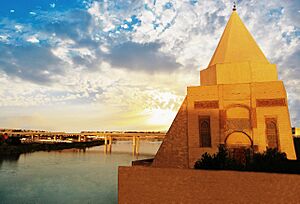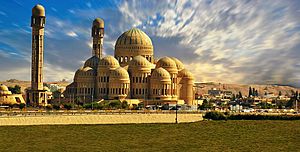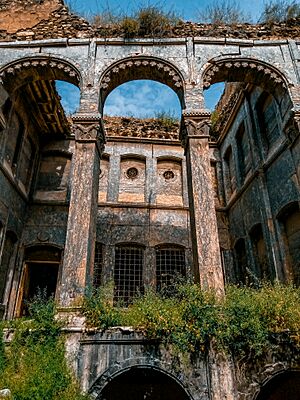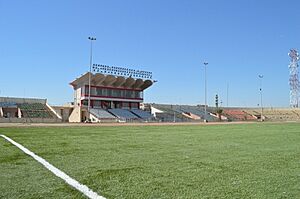Mosul facts for kids
Quick facts for kids
Mosul
الموصل
|
|
|---|---|
|
Top to bottom, left to right:
View over Tigris river Church of Saint Thomas • Hatra Mosul Rural area • The river's gate Mosul Museum • Heritage house |
|
| Nickname(s):
Nīnwē ܢܝ݂ܢܘܹܐ
The Pearl of the North |
|
| Country | |
| Governorate | Nineveh |
| District | Mosul |
| Area | |
| • Total | 180 km2 (70 sq mi) |
| Elevation | 223 m (732 ft) |
| Population
(2023)
|
|
| • Total | 1,792,000 |
| Macrotrends | |
| Demonym(s) | Mosuli Maslawi |
| Time zone | UTC+3 (AST) |
| Area code(s) | 60 |

Mosul (pronounced MOH-səl or moh-SOOL) is a very important city in northern Iraq. It is the capital of the Nineveh Governorate. Mosul is the second largest city in Iraq, after Baghdad, both in population and size. It is about 400 kilometers (250 miles) north of Baghdad. The city sits on the Tigris river. Locals call the two sides of the river the "Left Bank" (east) and "Right Bank" (west).
On the east side of Mosul are the ancient ruins of Nineveh. Nineveh was once the largest city in the world. Mosul is known for its rich history and culture in the Arab world. Because of its location, it has always been a major center for trade and travel. The local Arabic language, called Moslawi, is named after the city. Mosul and the nearby Nineveh Plains are also historical homes for the Assyrian people.
Mosul has a mix of different groups of people and religions. Most people are Arabs, but there are also Assyrians, Turkmens, Kurds, and other groups. The main religion is Sunni Islam, but there are many Christians and followers of other religions too. Historically, Mosul was famous for its marble and oil. The University of Mosul is also located here. It has a well-known Medical College and is one of the biggest learning centers in the Middle East.
Contents
Understanding the Name of Mosul
The name of Mosul first appeared in history around 401 BC. A Greek writer named Xenophon mentioned a small Assyrian town called "Mépsila" near where Mosul is today. This old name is likely the root of the city's current name.
In Arabic, the name "Mawsil" means "linking point" or "Junction City." This name makes sense because Mosul connects different regions. On the eastern side of Mosul are the ruins of the ancient city of Nineveh. Many Assyrians still call the whole city Nineveh.
Mosul has several nicknames, like al-Faiha ("the Paradise") and al-Khaḍrah ("the Green"). It is also called al-Hadbah ("the Humped") because of a famous leaning minaret. People sometimes call it "The Pearl of the North" and "the city of a million soldiers."
A Look at Mosul's Past
Ancient Times and Early Middle Ages
The area of Mosul has been part of Assyria for a very long time, since about 2500 BC. After the Akkadian Empire united Mesopotamia, Mosul remained part of Assyria. This continued until the fall of the Neo-Assyrian Empire around 612-599 BC. Even after that, Mosul stayed within the Assyrian region for another 13 centuries.
Nineveh was one of the oldest and most important cities in ancient times. People lived there as early as 6000 BC. It was a center for worshipping the goddess Ishtar. During the Neo-Assyrian Empire, Nineveh grew a lot. King Sennacherib made Nineveh the new capital around 700 BC. It became the largest city in the world. Some people even believe the Hanging Gardens of Babylon were actually in Nineveh.
The Assyrian Empire became weak due to civil wars. In 616 BC, many groups attacked Assyria. Nineveh fell in 612 BC after a long fight. The Assyrian king, Sin-shar-ishkun, died defending his city. Mosul, then a smaller town, later took Nineveh's place. It became a key point on the trade route connecting Assyria and Anatolia.
Mosul became part of the Seleucid Empire after Alexander the Great conquered the region in 332 BC. Then, the Parthian Empire took control around 150 BC. In 225 AD, the Sasanian Empire took over. Christianity arrived in Mosul as early as the 1st century. By the 6th century, it became an important center for the Assyrian Church of the East. In 637 AD, Mosul was taken by the Rashidun Caliphate during the early Arab Muslim conquests.
From the 9th Century to 1535
In the late 800s, Turkic rulers took control of Mosul. But by 893, it was back under the Abbasid Caliphate. In the early 900s, the local Arab Hamdanid dynasty ruled Mosul. They expanded their power across Upper Mesopotamia. Later, the Uqaylid dynasty took over.
The Seljuk Empire conquered Mosul in the 11th century. In 1127, it became the center of power for the Zengid dynasty. Saladin tried to capture Mosul in 1182 and again in 1185, but he failed. The city's strong defense and Saladin's illness stopped him. Mosul remained under Zengid control until 1234.
In 1258, the Mongol leader Hulagu invaded the region. Mosul's ruler, Badr al-Din Lu'lu', surrendered to the Mongols. This saved Mosul from being destroyed at that time. However, after the Mongols were defeated by the Mamluks in 1260, Mosul's ruler sided with the Mamluks. Hulagu then besieged Mosul for nine months and destroyed it in 1262. Mosul later regained some importance but never returned to its former glory.
In the early 1500s, Mosul was under the Turkmen federation of the Ağ Qoyunlu. But in 1508, the Safavid dynasty of Iran conquered it.
Metalworking in Mosul
In the 13th century, Mosul was famous for making beautiful brass items. These items were decorated with silver. Many of these pieces still exist today. They were very expensive and only the richest people could afford them. Mosul was a wealthy city at this time, which helped this industry grow.
The art of inlaying metal with silver first started in Khurasan in the 12th century. This skill then spread to other cities, including Mosul. By the early 1200s, Mosul's metalworking industry was thriving. Artists in Mosul were inspired by local miniature paintings.
Mosul became a leading center for metalwork in the early 13th century. Many artists from Mosul were known for their skills. However, after the Mongol siege in 1262, the industry likely declined. Many skilled workers moved to other cities like Damascus and Cairo.
Only two items are definitely known to have been made in Mosul. One is the Blacas ewer, made in 1232. The other is a silver-inlaid pen box from 1255/6. These items are part of a larger group of metalwork attributed to Mosul.
Some scholars call this group of metalwork the "Mosul School." This means Mosul had its own special way of making things. Many items shared unique symbols, like an octagon or a special rosette. These might have been like a "brand" or a "guild emblem." Mosul metalworkers were proud to record their relationships with their apprentices. This shows a strong community of skilled artisans.
Ottoman Rule in Mosul
In 1538, the Ottoman Empire took Mosul from Safavid Persia. From then on, a pasha (governor) ruled Mosul. The city was known for its strong walls, seven gates, a famous hospital, and busy markets. It was also known for its fabrics and trade.
Even though it was part of the Ottoman Empire, Mosul was quite independent for four centuries. Its culture developed more like Iraqi-Arab culture than Ottoman-Turkish. Turkish was the official language, but it wasn't the main language spoken in the province.
Mosul grew a lot in the 17th and early 18th centuries. This was because it was a stable trade route between the Mediterranean Sea and the Persian Gulf. The Al-Jalili family became very powerful in Mosul. They helped connect Mosul to its older Arab heritage.
In the 19th century, the Ottoman government wanted more control over its provinces. They stopped local elections for governors. They appointed new governors who were not from Mosul. This was to reduce the power of local families like the Jalilis. Mosul's importance as a trading center decreased after the Suez Canal opened. Goods could now travel by sea instead of through Mosul.
From 1918 to the 1990s
After World War I in October 1918, British forces took control of Mosul. After the war, Mosul became part of British-occupied Iraq. Later, it was part of Mandatory Iraq. Turkey disagreed with this, saying Mosul should be theirs.
In 1926, the League of Nations decided that Mosul would belong to Iraq. The former Ottoman province of Mosul became the Nineveh Governorate of Iraq. Mosul remained its capital.
Mosul's luck improved when oil was discovered in the area in the late 1920s. It became a key point for moving oil by truck and pipeline to Turkey and Syria. The University of Mosul opened in 1967, providing education for many people.
After Iraq's uprisings in 1991, Mosul was included in a "no-fly zone." This zone was patrolled by the United States and Britain. It stopped Saddam Hussein's forces from large military actions. However, Saddam's government still tried to change the population mix in some areas. Despite this, Mosul remained home to a mix of Arabs, Kurds, Assyrians, Armenians, Turkmens, Shabaks, and other groups.
The American-led Invasion of 2003
When the 2003 invasion of Iraq was planned, the U.S. wanted to use Turkey to attack northern Iraq and capture Mosul. But the Turkish parliament did not allow this. So, when the Iraq War started in March 2003, the U.S. mainly used air strikes and special forces. Mosul fell on April 11, 2003. Saddam's army left the city. U.S. Special Forces and Kurdish fighters quickly took control.
On July 22, 2003, Saddam Hussein's sons, Uday Hussein and Qusay Hussein, were killed in Mosul. This happened during a gun battle with Coalition forces. The U.S. Army's 101st Airborne Division used Mosul as its base. They helped with reconstruction, like fixing electricity, water, roads, and bridges.
In December 2007, Mosul International Airport reopened. A flight carried pilgrims to Baghdad. This was the first commercial flight since 1993. In May 2008, the Iraqi Army, with U.S. support, launched a military operation in Mosul. This was to bring stability and security to the city.
Between 2003 and 2008, many educated people left Mosul. Scientists, professors, doctors, engineers, and artists were killed or forced to leave. This was a difficult time for the city.
Christian Community in Mosul
In 2008, many Assyrian Christians (about 12,000) left Mosul. This happened after a series of murders and threats against their community. Some fled to Syria and Turkey. Others found shelter in churches and monasteries.
On June 10, 2014, the Islamic State (ISIL) took over Mosul. During ISIL's control, religious minorities were forced to convert to Islam, pay a special tax, leave, or be killed. The Christian community, which had been in the region since the 1st century, was severely affected.
People and Cultures in Mosul
Mosul has always been a place where different ethnic and religious groups live together. Today, the city center, west of the Tigris river, has mostly Sunni Arabs. Across the Tigris and in the northern suburbs, there are thousands of Assyrians, Kurds, Turkmens, Shabaks, Yazidis, Armenians, and Mandeans. Shabaks are mostly found on the eastern edge of the city.
Religions in Mosul
Mosul has a majority Sunni Muslim population. The city also had an old Jewish community. Most Jewish people left Mosul in 1950–51, moving to Israel or the United States. In 2003, an American army rabbi found an old, ruined synagogue in Mosul from the 13th century.
During ISIL's occupation, religious minorities were targeted. They were forced to convert to Islam, pay a tax, leave, or face death. This persecution caused the ancient Christian community to leave Mosul and the surrounding Nineveh Plains.
City Life and Buildings
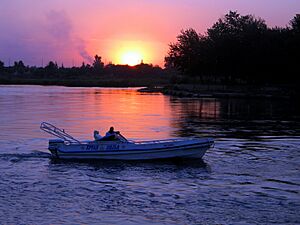
The Mosul Dam was built in the 1980s. It provides electricity and water to Mosul. However, water cuts are still common sometimes.
Five bridges cross the Tigris river in Mosul. They are known from north to south as:
- Al Shohada Bridge (Third Bridge)
- Fifth Bridge
- Old Bridge (Iron Bridge, First Bridge)
- Al Huriya Bridge (Freedom Bridge, Second Bridge)
- Fourth Bridge
During the Battle of Mosul (2016–17) against ISIL, many bridges were damaged. This was to stop ISIL forces from moving supplies. In January 2017, ISIL itself destroyed all bridges to slow down the Iraqi army.
After the battle, a lot of Mosul's buildings were damaged. Basic repairs were estimated to cost over 1 billion US dollars. Some areas were almost completely destroyed. Mosul is served by Mosul International Airport.
Mosul's Location and Weather
Mosul is located 223 meters (732 feet) above sea level. It is in the Upper Mesopotamia region. To the southwest is the Syrian Desert, and to the east are the Zagros Mountains.
Climate in Mosul
Mosul has a hot, dry climate. Summers are very hot and long. There are short, mild seasons in spring and autumn. Winters are moderately wet and relatively cool.
| Climate data for Mosul (1991-2020) | |||||||||||||
|---|---|---|---|---|---|---|---|---|---|---|---|---|---|
| Month | Jan | Feb | Mar | Apr | May | Jun | Jul | Aug | Sep | Oct | Nov | Dec | Year |
| Record high °C (°F) | 21.2 (70.2) |
26.9 (80.4) |
31.8 (89.2) |
36.5 (97.7) |
43.2 (109.8) |
47.4 (117.3) |
49.4 (120.9) |
49.3 (120.7) |
46.5 (115.7) |
42.2 (108.0) |
32.5 (90.5) |
28.4 (83.1) |
49.4 (120.9) |
| Mean daily maximum °C (°F) | 13.1 (55.6) |
15.4 (59.7) |
20.0 (68.0) |
25.9 (78.6) |
33.2 (91.8) |
39.8 (103.6) |
43.4 (110.1) |
43.3 (109.9) |
38.5 (101.3) |
31.9 (89.4) |
21.6 (70.9) |
15.1 (59.2) |
28.4 (83.2) |
| Daily mean °C (°F) | 7.4 (45.3) |
9.3 (48.7) |
13.3 (55.9) |
18.5 (65.3) |
25.1 (77.2) |
31.5 (88.7) |
34.8 (94.6) |
34.1 (93.4) |
28.8 (83.8) |
22.2 (72.0) |
14.8 (58.6) |
9.6 (49.3) |
20.8 (69.4) |
| Mean daily minimum °C (°F) | 2.6 (36.7) |
3.8 (38.8) |
7.5 (45.5) |
11.5 (52.7) |
16.6 (61.9) |
21.7 (71.1) |
25.4 (77.7) |
24.8 (76.6) |
20.0 (68.0) |
14.6 (58.3) |
7.9 (46.2) |
4.1 (39.4) |
13.4 (56.1) |
| Record low °C (°F) | −17.6 (0.3) |
−12.3 (9.9) |
−5.8 (21.6) |
−4.0 (24.8) |
1.8 (35.2) |
6.8 (44.2) |
11.6 (52.9) |
12.9 (55.2) |
8.9 (48.0) |
−2.6 (27.3) |
−6.1 (21.0) |
−15.4 (4.3) |
−17.6 (0.3) |
| Average precipitation mm (inches) | 61.6 (2.43) |
53.9 (2.12) |
59.4 (2.34) |
46.1 (1.81) |
17.5 (0.69) |
1.2 (0.05) |
0.2 (0.01) |
0.0 (0.0) |
0.6 (0.02) |
12.7 (0.50) |
41.7 (1.64) |
61.9 (2.44) |
356.8 (14.05) |
| Average precipitation days | 11 | 11 | 12 | 9 | 6 | 0 | 0 | 0 | 0 | 5 | 7 | 10 | 71 |
| Average relative humidity (%) | 79.0 | 73.0 | 66.3 | 62.1 | 44.2 | 29.3 | 26.2 | 27.4 | 32.0 | 43.8 | 63.1 | 76.5 | 51.9 |
| Mean monthly sunshine hours | 158 | 165 | 192 | 210 | 310 | 363 | 384 | 369 | 321 | 267 | 189 | 155 | 3,083 |
| Source 1: World Meteorological Organisation (precipitation days 1976-2008) | |||||||||||||
| Source 2: Weatherbase (extremes only), Meteomanz(extremes since 2009) | |||||||||||||
Historical and Religious Places
Mosul has many old historical and religious buildings. These include mosques, castles, churches, monasteries, and schools. Many have special architectural designs. The city center has narrow streets and old houses. The markets are lively, with people from many different backgrounds.
The Mosul Museum used to hold many ancient artifacts. These came from the old Assyrian capital cities of Nineveh and Nimrud. Sadly, on February 26, 2015, ISIL militants destroyed many of the museum's ancient Assyrian artifacts. The famous English writer Agatha Christie lived in Mosul for a time. Her husband, an archaeologist, was working on excavations nearby.
Mosques and Shrines
- Umayyad Mosque: This was the first mosque in Mosul, built in 640 AD. Its original part was a tall, leaning minaret called Al-Hadba (The Humped). It was mostly destroyed during the Battle of Mosul.
- The Great (Nuriddin) Mosque: Built by Nuriddin Zangi in 1172 AD, next to the Umayyad Mosque. It was also destroyed during the Battle of Mosul.
- Mujahidi Mosque: This mosque dates back to the 12th century. It is known for its special dome and decorated prayer niche.
- Prophet Younis Mosque and Shrine: Located east of the city, this shrine held the tomb of Prophet Younis (Jonah). It was completely destroyed by ISIL in July 2014.
- Prophet Jirjis Mosque and Shrine: This mosque and shrine from the late 14th century honored Prophet Jirjis (George). It was destroyed by ISIL in July 2014.
- Prophet Daniel Shrine: A tomb believed to belong to Prophet Daniel was destroyed by ISIL in July 2014.
- Hamou Qado (Hema Kado) Mosque: An Ottoman-era mosque built in 1881. It was destroyed by ISIL in March 2015 because it contained a tomb that local Muslims respected.
Churches and Monasteries
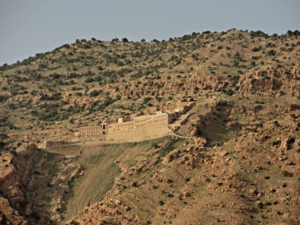
Mosul had a large number of Assyrian Christians. It has several old churches, some dating back to the early days of Christianity. These ancient churches are often hidden behind thick walls.
- Shamoun Al-Safa (St. Peter, Mar Petros): This church from the 13th century is named after St. Peter.
- Church of St. Thomas (Mar Touma): One of the oldest churches, named after St. Thomas the Apostle. Its exact founding date is unknown, but it existed before 770 AD.
- Mar Petion Church: This is the first Chaldean Catholic church in Mosul. It dates back to the 10th century and is 3 meters (10 feet) below street level.
- Ancient Tahira Church (The Immaculate): Near Bash Tapia, this is considered one of the oldest churches in Mosul. It dates back to the 7th century and is 3 meters (10 feet) below street level.
- Al-Tahera Church: A Syriac Catholic Church completed in 1862.
- Mar Hudeni Church: Named after Mar Ahudemmeh, this old church dates back to the 10th century. It is 7 meters (23 feet) below street level.
- St. George's Monastery (Mar Gurguis): One of the oldest churches in Mosul, located north of the city. It was probably built in the late 17th century.
- Mar Matte: This monastery is about 20 kilometers (12 miles) east of Mosul on a high mountain. It was built by Mar Matte, a monk who fled in 362 AD. It has a valuable library of Syrianic scriptures.
- Monastery of Mar Behnam: Also called Deir Al-Jubb, this monastery was built in the 12th or 13th century. It is near Nimrud, about 32 kilometers (20 miles) southwest of Mosul.
- St. Elijah's Monastery (Dair Mar Elia): Dating from the 6th century, it was the oldest Christian Monastery in Iraq. It was destroyed by IS in January 2016.
Other Christian historical buildings include:
- The Roman Catholic Church (built in 1893)
- Mar Michael
- Mar Elias
- Mar Oraha
- Rabban Hormizd Monastery, near the Assyrian town of Alqosh
Painting in Mosul
The "Mosul School of Painting" refers to a style of miniature painting. It developed in northern Iraq from the late 12th to early 13th century. This style was similar to the painting of the Seljuq Turks. However, Mosul artists had a stronger sense of realism. Most Mosul paintings were illustrations for books, like scientific works and poetry.
A painting from a 12th-century medical book, now in Paris, is a good example. It shows four figures around a seated figure. The painting uses many colors like reds, blues, greens, and gold. The writing is in blue. Another painting from the mid-13th century shows the preparation of a ruler's meal. By this time, the Baghdad school of painting became more popular. The Mosul school ended with the Mongol invasion in the mid-13th century. However, its style influenced later painting schools.
Learning in Mosul
The University of Mosul is the largest university in the city. Other higher education schools include Ninevah University, Al-Hadbaa University College, and the Northern Technical University.
Mosul also has many high schools. Some are for both boys and girls, while others are separate. These include:
- Al-Hafsah School
- Al-Haj Secondary School for Girls
- Kourtoba High School for Girls
- Al-Mouhobeen Secondary School for Boys and Girls
- Al-Mustaqbal High School for Boys
- Al-Mutamaizat High School for Girls
- Al-Mutamaizeen High School for Boys
- Al-Resalah Al-Islamia (Al-Resalah) High School for Boys
- Al-Sharqiya High School for Boys
Sports in Mosul
Mosul has one football team, Mosul FC, that plays in Iraq's top league.
Al Mosul University Stadium is the home stadium for Mosul FC. It can hold up to 20,000 people.
The University of Mosul has a College of Physical Education and Sports Science. It teaches students and does research in sports.
Famous People from Mosul
Many notable people have come from Mosul:
- Abdulahad AbdulNour: A doctor and humanitarian.
- Thabit AbdulNour: An Iraqi politician and diplomat.
- Zaha Hadid: A famous architect, the first woman to win the Pritzker award.
- Al Jalili, Hussein Pasha: Led the army to defend Mosul against Persian Shah Nadir Shah in 1743.
- Al Jalili, Ismael: An eye doctor who researched Jalili syndrome.
- Al Jamil, Sayyar: A historian and political analyst.
- Abu Al Soof, Behnam: An archaeologist, anthropologist, historian, and writer.
- Tariq Aziz: An Assyrian Deputy Prime Minister (1979–2003).
- Munir Bashir: An Assyrian musician.
- Asenath Barzani: The first Jewish female rabbi.
- Vian Dakhil: A Yazidi member of the Iraqi parliament.
- Hawar Mulla Mohammed: A Kurdish Iraqi soccer player.
- Paulos Faraj Rahho: Assyrian Chaldean Catholic Archbishop of Mosul, killed in 2008.
- Taha Yassin Ramadan: A Kurdish former Vice President of Iraq.
- Hormuzd Rassam: An Assyrian archaeologist and diplomat from the 19th century.
- Kathem Al Saher: An Arab Iraqi pop singer and actor.
- Adnan Koucher: An Iraqi scholar.
- Salah al-Din al-Sabbagh: An Arab Iraqi Army officer.
- Salah Salim Ali: A Norwegian-Iraqi writer and translator.
- Ignatius Gabriel I Tappouni: Assyrian Patriarch of Antioch (1929–1968).
- Behnam Afas: An Iraqi-New Zealander author and researcher.
- Ghazi Mashal Ajil al-Yawer: Arab Interim President of Iraq (2004–05).
- Ignatius Zakka I: Assyrian Patriarch of Antioch.
- Omar Mohammed: A historian and citizen journalist, creator of the Mosul Eye news blog.
- Loris Ohannes Chobanian: An Armenian-American composer and professor.
Images for kids
-
Map of Mosul in 1778, by Carsten Niebuhr.
-
Saddam Hussein's sons Qusay and Uday were killed in Mosul in 2003.
-
A souk (traditional market) in Mosul, 1932.
See also
 In Spanish: Mosul para niños
In Spanish: Mosul para niños


